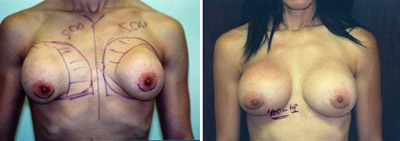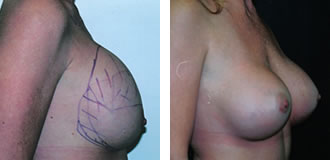Reasons for Breast Augmentation Revision
Posted On: June 10, 2015 Author: The Office of Dr. Stuart Linder Posted In: Breast Implants, Breast Revision, Breast topics, Uncategorized
Reasons for Breast Augmentation Revision
Breast augmentation surgery involves the insertion of implants to enhance the size, shape, and projection of a woman’s breasts. This procedure generally leaves patients feeling beautiful, confident, and comfortable in their new bodies. However, complications or concerns may arise that need to be corrected by a secondary surgery.
Breast Size
Even with today’s technology, surgeons can only use there experience as to how an implant will look once it is placed. Sometimes, it is hard to vocalize what you wish your results to be. You can do your best and your surgeon can do his or her best to meet the image in your head. Since deciding implant size can be a gray area, some women find that their breasts aren’t the size they were hoping for after the procedure. In some cases, the implant chosen is too small and they are disappointed. In other cases, the implant is far too large and they feel disproportionate in a way different from before. In these cases, breast revision surgery may be needed to change implant size.
Capsular Contracture
When an implant is inserted into the breast, a tissue capsule forms around it. For unknown reasons this tissue can begin to shrink and squeeze the implant. The tighter the implant is compressed, the firmer it begins to feel. This complication is known as capsular contracture. There are four grades of capsular contracture:
-
Grade I: the breast looks and feels soft inside the natural tissue capsule.
-
Grade II: the breast looks normal but feels firm.
-
Grade III: the breast has become distorted by the contracture and feels firm.
-
Grade IV: the breast looks distorted, feels firm, and is painful.
 Either an open capsulotomy or an open capsulectomy is performed to correct capsular contracture. During a capsulotomy the capsule is cut in order to release its hold on the implant. A capsulectomy involves completely removing the current capsule so the body can form a new one.
Either an open capsulotomy or an open capsulectomy is performed to correct capsular contracture. During a capsulotomy the capsule is cut in order to release its hold on the implant. A capsulectomy involves completely removing the current capsule so the body can form a new one.
A Ruptured or Leaking Implant
In a small percentage of patients, their implants rupture. When this occurs with a saline implant, the saltwater will harmlessly leak into the body and the implant will deflate. When a silicone implant ruptures, the gel leaks into the capsule that has formed around it. Ruptures to silicone implants are harder to detect. To correct a ruptured implant, the broken one is removed and a new implant is inserted. In cases involving silicone implants, the scar tissue is removed to ensure that all traces of the gel have been excised from the body.
Double Bubble Deformity
 “Double bubble” refers to the image created when the breast tissue falls under the implant. This typically occurs when the implant settles high on the chest either because of implant placement or capsular contracture. The surrounding breast tissue then sags, creating the appearance of two bubbles. Double bubble doesn’t always occur right after the primary breast augmentation; it can form after the breasts begin to droop due to age or pregnancy. Correcting double bubble deformity may involve a breast lift or repositioning of the breast implant.
“Double bubble” refers to the image created when the breast tissue falls under the implant. This typically occurs when the implant settles high on the chest either because of implant placement or capsular contracture. The surrounding breast tissue then sags, creating the appearance of two bubbles. Double bubble doesn’t always occur right after the primary breast augmentation; it can form after the breasts begin to droop due to age or pregnancy. Correcting double bubble deformity may involve a breast lift or repositioning of the breast implant.
If you are interested in breast revision surgery, please call (310) 275-4513 or fill out our online contact form today. Dr. Stuart A. Linder is a breast surgery specialist and is ABPS Board Certified in Plastic Surgery. He looks forward to helping you attain the breasts and confidence you deserve.